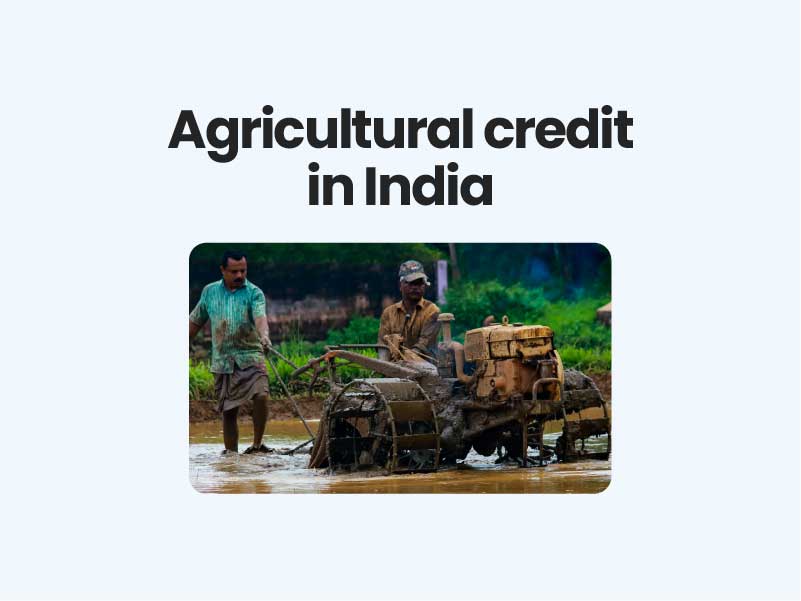Companion@360 → 7 Month programme to sharpen your writing skills → REGISTER NOW

Agricultural credit in India
Agricultural credit is considered as one of the most basic inputs for conducting all agricultural development programmes. In India, there is an immense need for proper agricultural credit as Indian farmers are very poor. From the very beginning, the prime source of agricultural credit in India was moneylenders.
After independence, the Government adopted the institutional credit approach through various agencies like co-operatives, commercial banks, regional rural banks etc. to provide adequate credit to farmers, at a cheaper rate of interest. Moreover, with growing modernisation of agriculture during the post-green revolution period, the requirement of agricultural credit has increased further in recent years.
Types of agricultural credit
Considering the period and purpose of the credit requirement of the farmers of the country, agricultural credit in India can be classified into three major types
- Short term credit: The Indian farmers require credit to meet their short term needs viz., purchasing seeds, fertilizers, paying wages to hired workers etc. for a period of less than 15 months. Such loans are generally repaid after harvest.
- Medium-term credit: This type of credit includes credit requirement of farmers for a medium period ranging between 15 months and 5 years and it is required for purchasing cattle, pumping sets, other agricultural implements etc. Medium-term credits are normally larger in size than short term credit.
- Long term credit: Farmers also require finance for a long period of more than 5 years just for the purpose of buying additional land or for making any permanent improvement on land like the sinking of wells, reclamation of land, horticulture etc. Thus, the long term credit requires sufficient time for the repayment of such loan.
Read GS Notes India and Its Neighbourhood
Sources of agriculture credit
Apart from the moneylenders, cooperative credit sources and the government, nowadays, the long term and short term credit needs of institutions are also being met by National Bank for Agricultural and Rural Development (NABARD).
Sources of agricultural credit can be broadly classified into institutional and non-institutional sources. Non-Institutional sources include moneylenders, traders and commission agents, relatives and landlords, but institutional sources include co-operatives, commercial banks including the SBI Group, RBI and NABARD.
Commercial banks
In the initial period, the commercial banks of our country have played a marginal role in advancing rural credit. With the help of “village adoption scheme” and service area approach the commercial banks started to meet the credit and other requirements of the farmers. They also sponsored various regional rural banks for extending credit to small and marginal farmers and rural artisans just to save them from the clutches of village moneylenders.
Commercial banks are finding difficulty in advancing loans to the farmers particularly in respect of lending techniques, security, recovery etc. and are expected to overcome these gradually. But the commercial banks are not very much interested to advance loan to small and marginal farmers.
Government:
Another important source of agricultural credit is the Government of our country. These loans are known as taccavi loans and are lend by the Government during emergency or distress like famine, flood etc. The rate of interest charged against such loan is as low as 6 per cent. During 1990-91, the state Governments had advanced nearly Rs 350 crore as a short-term loan to agriculture. But the taccavi loan failed to become very much popular due to official red-tapism and corruption.
Credit facility to farmers:
Kissan credit card: The Kissan Credit Card (KCC) scheme was launched in 1998 with the aim of providing short-term formal credit to farmers. Owner cultivators, as well as tenant farmers, can avail loans to meet their agricultural needs under this scheme at attractive rates of interest. The government has also simplified the application process to increase interest among farmers. Repayment is also simplified and dependent on the harvesting season, reducing the farmers’ debt burden.
Investment loan: Loan facility to the farmers is available for investment purposes in the areas viz. Irrigation, Agricultural Mechanization, Land Development, Plantation, Horticulture and Post-Harvest Management.
Interest subvention scheme: The interest subvention scheme for farmers aims at providing short term credit to farmers at the subsidised interest rate. The policy came into force with effect from Kharif 2006-07. The scheme is being implemented for the year 2018-19 and 2019-20.
The interest subvention will be given to Public Sector Banks (PSBs), Private Sector Banks, Cooperative Banks and Regional Rural Banks (RRBs) on use of own funds and to NABARD for refinancing to RRBs and Cooperative Banks.
The Interest Subvention Scheme is being implemented by NABARD and RBI.
Read Also K-Shaped Economic recovery
Problems regarding Agricultural credit in India
- Insufficiency: In spite of the expansion of rural credit structure, the volume of rural credit in the country is still insufficient as compared to its growing requirement arising out of the increase in prices of agricultural inputs.
- Inadequate amount of sanction: The amount of loan sanctioned to the farmers by the agencies is also very much inadequate for meeting their different aspects of agricultural operations. Considering the amount of loan sanctioned as inadequate and insignificant, the farmers often divert such loan for unproductive purposes and thereby dilute the very purpose of such loan.
- Lesser attention of poor farmers: Rural credit agencies and its schemes have failed to meet the needs of the small and marginal farmers. Thus, lesser attention has been given on the credit needs of the needy farmers whereas the comparatively well-to-do farmers are getting more attention from the credit agencies for their better creditworthiness.
- Inadequate institutional coverage: In India, the institutional credit arrangement continues to be inadequate as compared to its growing needs. The development of co-operative credit institutions like Primary agricultural credit societies, land development banks, commercial banks and regional rural banks, have failed to cover the entire rural farmers of the country.
- Red tapism: Institutional agricultural-credit is subjected to red-tapism. Credit institutions are still adopting cumbersome rules and formalities for advancing loan to farmers which ultimately force the farmers to depend more on costly non-institutional sources of credit.
UPSC Prelims Mock Test UPSC Mains Answer Writing
Solutions
- To monitor the taccavi loan offered by the Government in a serious manner.
- Co-operative credit societies should be organised to make it efficient and purposeful for delivering the best in terms of rural credit. Moreover, these societies may be transformed into a multi-purpose society with sufficient funding capacity.
- Middlemen existing between credit agencies and borrowers should be eliminated.
- Reserve Bank of India should arrange sufficient fund so that long term loans can be advanced to the farmers.
- Power and activities of the Mahajans and moneylenders should be checked so as to declare an end to the exploitation of farmers.
- The banks should adopt procedural simplification for credit delivery through rationalisation of its working pattern.
- In order to check the fraud practices adopted by the farmer, for getting loans from different agencies by showing same tangible security, a credit card should be issued against each farmer which will show the details about the loans taken by them from different agencies.
- Credit should also monitor the actual utilisation of loans by developing an effective supervisory mechanism.
Daily Prelims Question Join Telegram Channel


